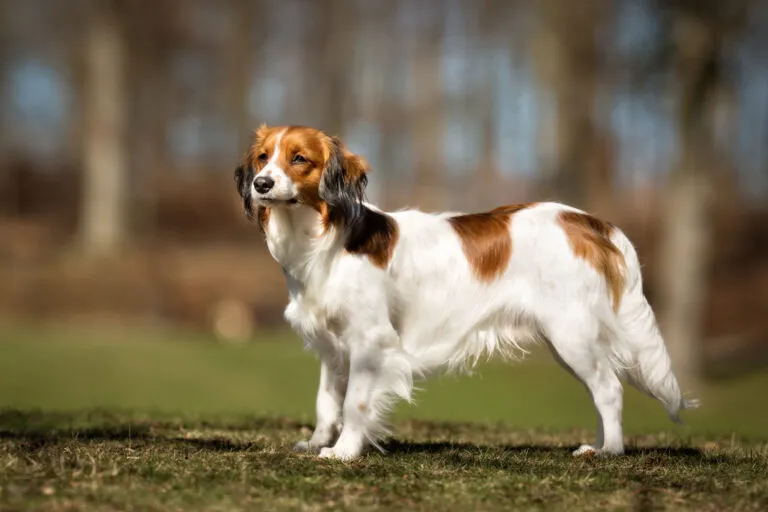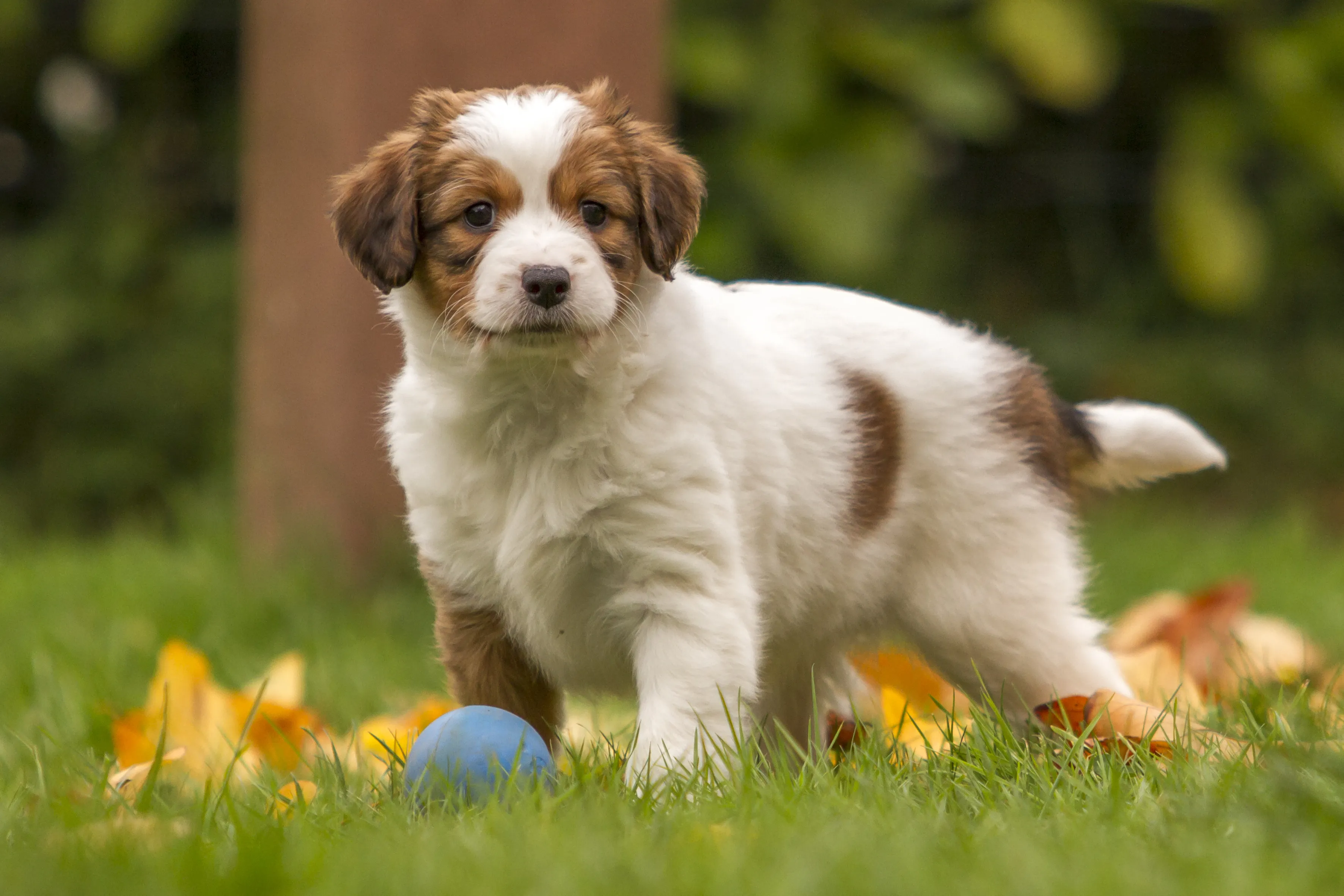Medium Size Poodle
The Kooikerhondje was originally deployed in the Netherlands for tempting ducks as a red herring. Nowadays the cheerful nature of these little Dutch waterfowl dogs charms more and more dog lovers.

© Mikkel Bigandt / stock.adobe.com
Typical features of the Kooikerhondje are reddish-orange markings on white fur as well as its black ear tips, which are also known as earrings. Its head should have a white emblem known as a blaze. At 38 to 40cm in shoulder height, it is a medium-sized dog with a well-proportioned body. The Kooikerhondje’s well-feathered tail is held straight or above the topline. Its ears are also well-feathered and frame the elegant head with expressive eyes. The fur is medium-length and can be smooth or slightly wavy. It feels soft, should be longer in the chest area and has a thick undercoat.
Kooikerhondjes were originally bred for a special form of duck hunting in the Netherlands which was popular in the 16th century. The Netherlands are rich in rivers and ponds, so a type of hunting adapted to the environment was able to develop. Hunters laid bushes and mats around a body of water, which were to form a natural cage, called “kooi” in Dutch. Tame ducks were then released as decoys and encouraged wild ducks to land, which was when the Kooikerhondje came into the picture. It is more an enticer than hunter of dogs: its task during hunts was to tempt curious ducks into the cage around the shores by dancing around with a wagging tail. There the ducks were caught and slaughtered. Although there are still koois in the Netherlands, they are primarily used for scientific purposes, for instance, ringing birds. Kooikerhondjes are deployed for this purpose too.
In fact, the Kooikerhondje almost became extinct during the Second World War, but the Baroness van Hardenbroek van Ammerstol used pictures to search for specimens of the breed. A female dog Tommy was found in Frisia and is considered the progenitor of the breed, allowing a revival of the breed to begin in 1942, whereby historical archetypes of the breed were established as the goal. Breeders started with just 25 animals overall. Kooikerhondjes had reestablished as early as 1971 and were recognised by the FCI as an independent breed. The population is nowadays stable. Their appearance and behaviour bring to mind the Nova Scotia Duck Tolling Retriever, although the extent to which this breed has been influenced by the Kooikerhondje is not proven. In the US, Canada and Scandinavia too, the easy-doing Kooikerhondje is attracting more and more interest from dog lovers.
A Kooikerhondje is a cheerful and playful companion that forms a very close bond with its human pack. Despite its vigilance, it doesn’t tend to yap or get aggressive. The Kooikerhondje remains playful up to old age and loves being tickled. In a nutshell, the Kooikerhondje is a good-spirited dog that wins over people and fellow dogs with its charm. It can be a wonderful companion to children as long as they give it chance to retreat and have learnt how to treat animals with respect. It is generally distanced towards strangers.
 © Sabine Glässl / stock.adobe.com
© Sabine Glässl / stock.adobe.com
Due to working closely with humans for centuries, the Kooikerhondje happily forms close attachments to them nowadays too. It isn’t just obedient, but very quick to learn too. First-time owners too can easily train these intelligent dogs as long as they do research and offer consistent leadership. If not, there is the danger that the Kooikerhondje will test its boundaries and rebel. However, if you give clear guidelines and praise your dog when it does something right, training will be easy. Praise is usually more appealing to the Kooikerhondje than treats! It has little hunting instinct, since the purpose of its ancestors was to entice rather than hunt ducks, although some Kooikerhondjes do like to pursue small animals like rats. Hence, focus in training on retrievability from an early age. A puppy school and continued training at a dog school are practical for an all-round sociable and well-trained dog.
If you wish to have a healthy Kooikerhondje, you should definitely buy from a serious breeder. This is the most important requirement for an energetic dog. This breed tends to suffer from health problems if the parent animals weren’t selected by an experienced breeder or examined by a vet regarding their health. Possible genetic dispositions include kidney diseases, luxating patella and ocular disorders. In the past Von Willebrand’s Disease occurred frequently. However, this disease barely occurs any more amongst this breed thanks to appropriate selection. A severe disease is hereditary necrotising myelopathy of the Kooikerhondje, which only affects this breed. This is a severe and fatal neurological disorder associated with progressive paralysis. Since 2012, there has been a genetic test that all scrupulous breeders should carry out on the dogs they deploy for breeding. Healthy Kooikerhondjes can live to be 14 years of age or more.
Most Kooikerhondjes have a good appetite, which you should definitely keep under control so that your dog doesn’t gain excess weight. Give it a food rich in protein primarily containing meat. Hence, choose a high-quality wet or dry food with plenty of meat and free of grain and sugar. A top tip is to give adult dogs one portion of wet food each day and the rest in the form of dry food. Also weigh out the quantity of dry food for the day and divide it up as a treat for training sessions or keep it on hand for search games. If you wish to give extra treats, suitable options are dental care snacks or dried meat snacks. You can give your Kooikerhondje special chew bones for dogs and dried treats like cattle ears as a tasty treat. Water should always be freely available to your canine companion.
The medium-length fur is made up of an undercoat and top hair. Kooikerhondjes are very straightforward in terms of grooming: brush it every two days to remove loose hairs. If it gets dirty, it’s generally sufficient to brush dried dirt out of its fur. Only in exceptional cases should you give your Kooikerhondje a bath with a mild dog shampoo. Don’t just get your dog used to grooming in the form of brushing when it is still a puppy, but baths too so that it isn’t scared of them later on. Use tick tweezers to remove unwelcome guests should this be required. Claw clippers are helpful for older Kooikerhondjes in particular, because they often don’t wear down their claws enough. This can lead to injuries, so cut their claws regularly. If you are unsure of how to do this, you’re better off getting a vet to show you at first.
 © DoraZett / stock.adobe.com
© DoraZett / stock.adobe.com
A Kooikerhondje makes an excellent companion for sporty people: this breed loves going on long hikes with you or accompanying you jogging, horse riding or on bike rides. However, the Kooiker wants to be mentally stimulated too. Be it agility, flyball or dog dancing, your Kooikerhondje is mostly happy to take part in everything! Retrieval games, obedience and tracking work are also well suited to these dogs. One reason for its interests is that historically it is one of the utility dogs that worked very closely with humans – it’s great fun for them! You can also try things out to see what you both like best. Be it as a companion or for dog sport, you should only start intensive training once your dog is of adult age!
A Kooikerhondje is a good fit for many dog lovers — families or singletons. It is suitable for first-time owners and can live happily in cities if it gets enough exercise and activity. Of course it enjoys having a fenced garden in which it can play and frolic to its heart’s content. Whether children or other pets, a well-socialised Kooiker mostly gets on wonderfully with all members of the pack. It loves the company of its human family, therefore shouldn’t have to stay alone for too long. Consider this before choosing a Kooikerhondje. It can accompany you to the office if it gets occasional activity whilst it is there. A Kooiker can be taken on holiday with no problems if you are planning a hiking holiday, for instance.
You should enjoy spending time outdoors if you choose this breed: at least one to two hours of exercise each day should be possible. Occasional training sessions and games supplement this. Hence, give some consideration to whether you can dedicate the necessary time to your future dog for the next 14 years or more before opting for a Kooikerhondje puppy.
Along with time commitments come costs too: not just the purchase price has to be taken into consideration, but basic equipment from bowls to leads to carriers and beds. The ongoing costs need to be considered too, which include a high-quality dog food, liability insurance and regular trips to the vet.
If you’re looking for a Kooikerhondje, you need a serious breeder affiliated with an association. Although Kooikerhondjes are still relatively rare, the number of puppies are increasing. Make sure that the breeder offers comprehensive healthcare provision and willingly gives you information about their breeding objectives. A big advantage of responsible breeders is that they offer puppies that are both healthy and mentally strong.
A puppy should enter its new home at the age of eight weeks at the earliest, ideally later. Along with a small supply of its usual food, it should also come with its paperwork and a vaccination record. It should have been microchipped and vaccinated and dewormed on multiple occasions. Take your new housemate to the vet as soon as possible in order to schedule appointments for follow-up vaccinations.
If you’re looking for an older Kooikerhondje, it’s very rare to strike lucky in the local animal shelter, because this breed is relatively rare. Kooikerhondje associations will help you look for adult dogs that need a new home.
We wish you plenty of joy with your cheerful Kooikerhondje!
Fans of the Bearded Collie agree that those who aren't familiar with this dog breed simply have to get acquainted with it. And those who have experienced how a Bearded Collie bolts across meadows with its flowing fur, how it rolls around full of energy and joy and how it attentively and observantly takes into account its owners wishes become simply addicted to this original dog breed and its unique charm.
The Goldendoodle isn't a breed, but a pairing between Golden Retrievers and Medium or Standard Poodles. Marketed as a low-maintenance dog for allergy sufferers, this hybrid is enjoying increasing popularity amongst dog lovers, similar to the Labradoodle.